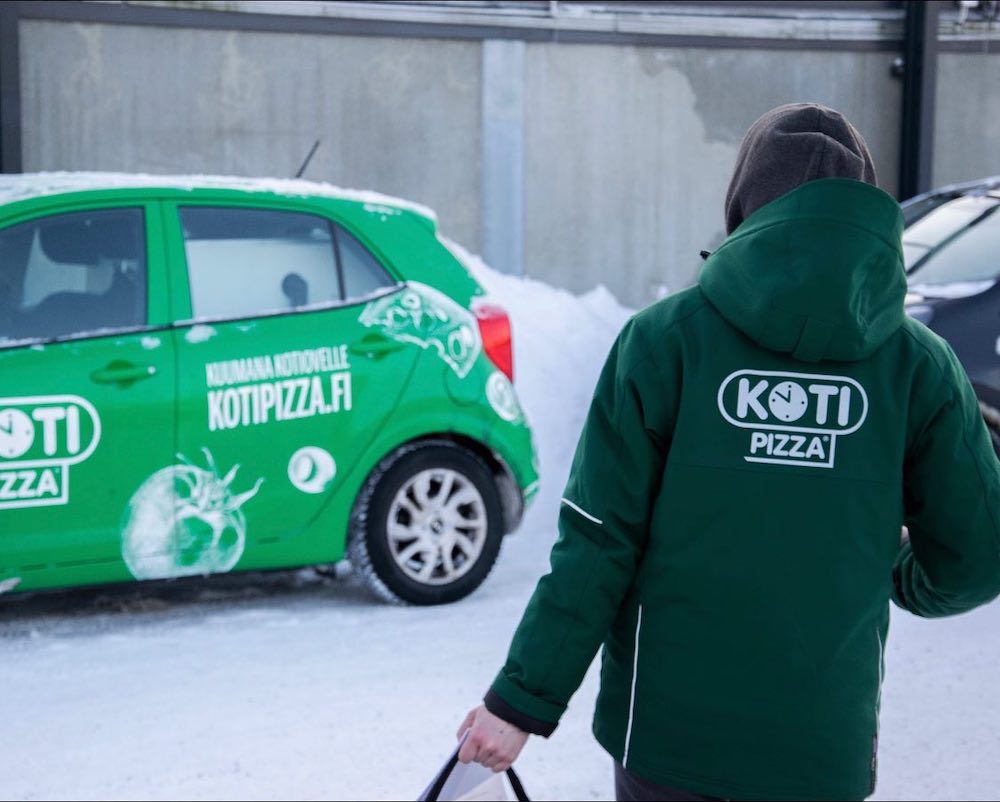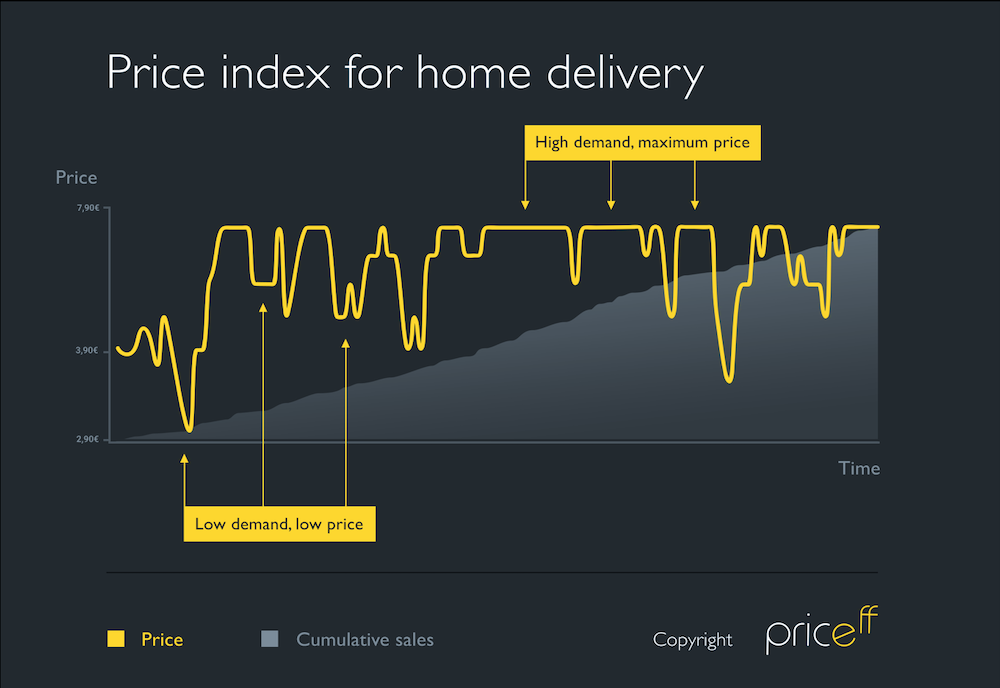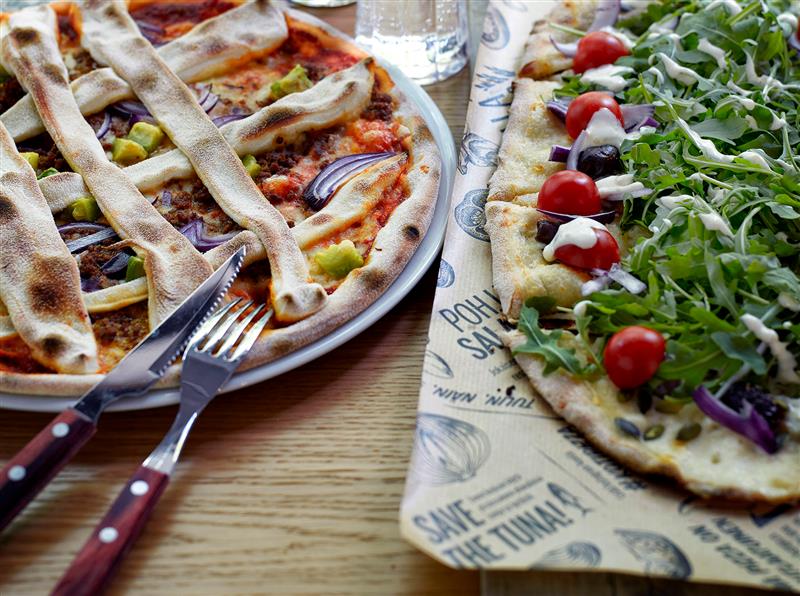- Kotipizza uses a specialized algorithm to set its delivery fees—and to keep resetting them all day long—in a model called dynamic pricing.
- As determined by the algorithm, the delivery fee for a pizza order changes at five-minute intervals based on demand.
Related: Delivery has been a game-changer for Little Caesars
By Rick Hynum
For many Americans these days, “algorithm” is a troubling word—although they might not know exactly what it means. It sounds a little mysterious, even esoteric. Disinformation on social media quickly springs to mind, as does online privacy—or lack thereof. But pizza makers have been using algorithms all their lives, whether they realize it or not. Simply put, an algorithm is a sequence of instructions for performing a task. Your dough formula is essentially an algorithm. So is your grandmother’s recipe for lasagna.
Facebook, Twitter and Amazon built their success on more complex computer-based algorithms, and major pizza chains like Domino’s have put them to profitable use as well. But no one in the pizza industry uses algorithms quite like Kotipizza, the No. 1 pizza chain in Finland.
Founded by Rabbe Grönblom in 1987, Kotipizza grew into the first national franchising pizza chain in Finland. The company now has 294 franchisee-operated units in every part of the country, according to Johanna Kuosmanen, the company’s digital and customer experience director. From Lapland to Helsinki, Kotipizza has become a household name, she notes, with a brand recognition of 99%. Kotipizza’s sales totaled €151.4 million ($174 million in U.S. dollars) in 2020, but they’ve continued to grow in 2021—in July, monthly sales topped €15 million ($17.3 million) for the first time.
As with many American pizza chains, digital ordering and technology have been crucial to the chain’s growth over the past two decades. What sets Kotipizza apart from Domino’s, though, is how the company uses a specialized algorithm to set its delivery fees—and to keep resetting them all day long—in a model called dynamic pricing. Kotipizza is the first European pizza company to use dynamic pricing specifically for home delivery, letting demand drive the price. And what they’ve learned over the past two years could change the pizza industry worldwide.

Kotipizza’s drivers make pizza deliveries in elaborately branded vehicles.
The Price Is Right
Dynamic pricing is hardly a recent innovation. Airlines and hotels have been using it for decades to set prices for flights and rooms. A plane ticket to Seattle might cost you less if you order it today and more if you wait until next week. Hotels charge more on weekends than on weekdays. The same idea applies with Kotipizza’s dynamic pricing algorithm. “It means that the price of pizza delivery is determined by demand,” Kuosmanen explains. “The price is lower when the demand is lower and vice versa. In practice, the price of delivery fluctuates between €2.90 ($3.35) and €7.90 ($9.13).”
Kotipizza partnered with tech company Priceff, co-founded by Anders Ekholm, to solve a problem that’s common to pizzerias everywhere. “The demand for pizza is very high between Friday and Sunday, whereas the beginning of the week is very slow, and, from our experience, no amount of campaigning can boost it very much,” Kuosmanen says. “We wanted to find a way to boost demand during the slow period early in the week, and Priceff’s model offered a unique way to do that.”
Related: Why these pizza chains work with third-party delivery platforms
Inspired by fluctuating prices for plane tickets and flaws in the airlines’ model, Ekholm developed an algorithm that doesn’t need to predict demand—it’s based on current demand itself. He applied for a patent in the U.S. in 2010, launched Priceff in 2016 and received approval on his patent in 2017. Kotipizza was one of Priceff’s early adopters.
So how does dynamic pricing for pizza delivery work? First, customers can take advantage of dynamic pricing only by placing an order digitally. As determined by Priceff’s algorithm, the delivery fee for the order changes at five-minute intervals based on demand. If only a few people are ordering at a particular time, the fee for delivery drops a bit. On slow days, typically Monday through Wednesday, the fee is considerably lower, and it climbs higher on peak days, during the latter part of the week.

Kotipizza’s actual menu prices stay the same, as Kuosmanen points out. It’s only the delivery fee that changes, depending on the day and even the time of the day. That means customers looking for a better deal on, say, Tuesday night can keep an eye on the fluctuating fee and try to order at the perfect time to save the most money.
Not surprisingly, Kotipizza’s algorithm needed a little tweaking at first, Kuosmanen says. “We ran the first nationwide pilot in May 2019, and that taught us that the process has to be more sensitive to local demand….It has been very much a learning process.”
The problem, she says, was that the delivery price in the early pilot stage “was determined by overall demand in the whole country. But that didn’t work, since demand can vary quite differently in different parts of the country or even in different parts of one town, and the algorithm needed to be tweaked and made more sensitive to location. We had to find the right balance so that the price reacts to actual demand in the place where the restaurant and the customer are located.”
After that first pilot test, franchisees “weren’t too happy with it,” Kuosmanen says. But Kotipizza kept trying. “It was important to find the right model and convince the franchisees of its benefits. So it was also a question of internal communications and marketing.”
Fortunately, the next pilot, executed in 10 Kotipizza restaurants in 2019, was “considerably more successful,” she says. “In September 2020, the model was adopted by all 60 restaurants offering delivery in southern Finland, and currently it runs in 75 restaurants. By November, all 200 delivering restaurants throughout the country will be using it.”
Related: Domino’s rolls out self-driving robotic delivery car in Houston

Multiple Benefits
In theory, dynamic pricing decreases demand variation—in other words, it reduces the difference in delivery demand between peak hours and quiet times. It works in practice, too, Kuosmanen says. “It has done exactly what it set out to do: boost sales during the slow period early in the week. In the southern part of Finland, there has been a growth of 21% in units delivered and 20% in delivery sales.”
Dynamic pricing improves the overall delivery experience, too. “Another concrete customer benefit is the fact that dynamic pricing has raised the availability of delivery and lowered delivery times during peak hours,” Kuosmanen notes. “And there is also a segment of customers who are very engaged with the model and like to play around with it.” After all, if a customer wants to score the best possible delivery deal from Kotipizza, they need to keep a close eye on the app and the fluctuating fee. That vigilance helps forge a unique bond between the customer and the brand—they’re more likely to think about ordering from Kotipizza first, because not only can they place a delivery order for less money at certain times of the day or week, the digital-ordering process also turns into a fun game. “The model builds brand engagement and loyalty as well,” Kuosmanen says.
Alexander MacKay, an assistant professor at Harvard University Business School, researches the economics of competition, including pricing, demand and market structure. In a recent webinar hosted by Priceff, he described dynamic pricing as “a really exciting space.” He added, “I absolutely believe that dynamic pricing—sort of smart pricing, more generally—is going to really have an important impact on the way that people do business.”
MacKay noted that various retailers already use third-party pricing software. “For $80 a month, you can get prices that update every hour,” he said. “For $250 a month, you can upgrade your frequency to get instant repricing. So there’s a cost-benefit analysis here. What am I gaining from faster pricing? Is it worth the additional [$170] a month? In addition to pricing frequency…you get to pick what pricing rule you want to set, and you can track what your competitors are doing and adjust your prices accordingly.”
Related: How to hire, train and retain better delivery drivers in the COVID-19 era

But dynamic pricing hasn’t exactly taken off in the restaurant industry so far. A few restaurants in the U.S. and Europe have tinkered around with dynamic pricing for their menus in recent years, reducing food prices during slow periods for dine-in customers. For example, after pivoting to carryout in the early phase of the COVID-19 pandemic last year, Restaurant Olivia, a pasta-focused Italian trattoria in Denver, reopened its dining room in June 2020 with a limited dynamic-pricing model. The restaurant started offering the same fixed-price menu (for four-course and six-course meals) at a lower price at 5 p.m. and 9 p.m. on weekdays, compared to 7 p.m. on weekdays or on weekends. Four months later, however, Restaurant Olivia co-owner Austin Carson admitted to the Denver Business Journal that the dynamic-price approach wasn’t making a difference in customer behavior and needed more tweaking. As of now, the restaurant’s menu features only a single price—$115—for a four-course meal, regardless of the hour or day of the week.
But, as that $115 figure suggests, Restaurant Olivia is an elegant, upscale operation. Many of its customers are likely not price-conscious bargain hunters. Pizza delivery is a different world, and executives at Kotipizza know it. In fact, they plan to give dynamic menu pricing a try in the future. “We are already looking into that,” Kuosmanen says. “The process will be very similar—and hopefully easier since we’ve already learned so much. We’ll start with local pilots and take the model nationwide gradually.”

More Freedom of Choice
To educate its customers about dynamic pricing, Kotipizza ran campaigns on social media and its online store every time the model was introduced in a new region. “The model didn’t need much explaining, since most consumers are already familiar with dynamic pricing and have encountered it while booking flights or hotel rooms,” Kuosmanen says. “In our messaging, we emphasized the fact that the model gives the customer more freedom of choice: ‘You get to decide how much delivery costs.’”
The strategy paid off for Kotipizza during the pandemic, which hit Finland just as hard as the rest of the world. “Overall, restaurant sales in Finland were down by 25% in 2020,” Kuosmanen says. “However, the damage was spread very unevenly, and some restaurants managed to do well, especially ones that had invested in their own online stores and in-house delivery systems and were not dependent on outside delivery platforms. Kotipizza’s chain sales were up 13.6% in 2020, thanks to the online store and delivery. The share of online sales quickly jumped from less than 20% before the pandemic to around 50% and continue to rise to this day….[Dynamic pricing] has been a major part of our success during the pandemic.”
Related: How to make third-party delivery work for your pizzeria
In the Priceff webinar, Tommi Tervanen, Kotipizza’s chairman of the board, said experimenting with new ideas is essential to success in the pizza industry. “I believe strongly that two touch points will be the winning formula in the future: the experience you get, first, on the mobile app, and, second, when your doorbell is ringing and the pizza gets handed to you. Those are really big quality issues.”
Through dynamic pricing for delivery, Tervanen adds, “We have been able to create traffic in the quiet hours, but we’ve also been able to get the maximum price in the peak hours. The restaurant business is quite a lot from Friday through Sunday, and Monday through Thursday are the quiet days. So [dynamic pricing] kind of evens out our demand, increases frequency and really drives up the average ticket. That’s the key when working with your franchisees, so that their [delivery strategy] and profitability are great all the time.”
Kuosmanen says Kotipizza aims to be “even more data-driven” in the future. “We continue to optimize the delivery price even more according to demand and location. Regional differences in prices can be made to fluctuate even more. The pricing model can also have more tactical uses. Instead of ‘free delivery’ campaigns, we can just make the dynamic delivery price start from zero. Not to mention all of the possibilities the dynamic pricing model has when it comes to menu items.”















